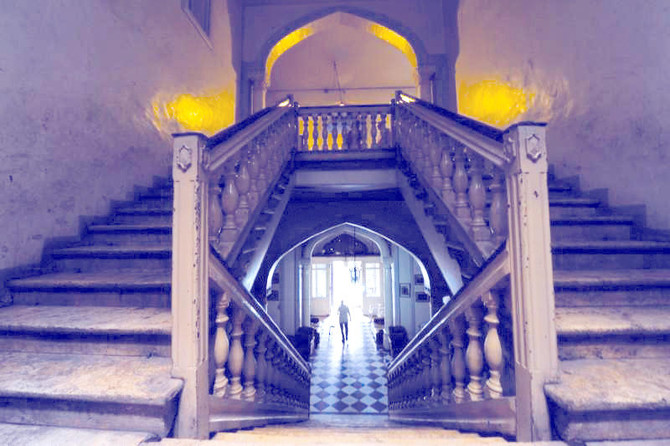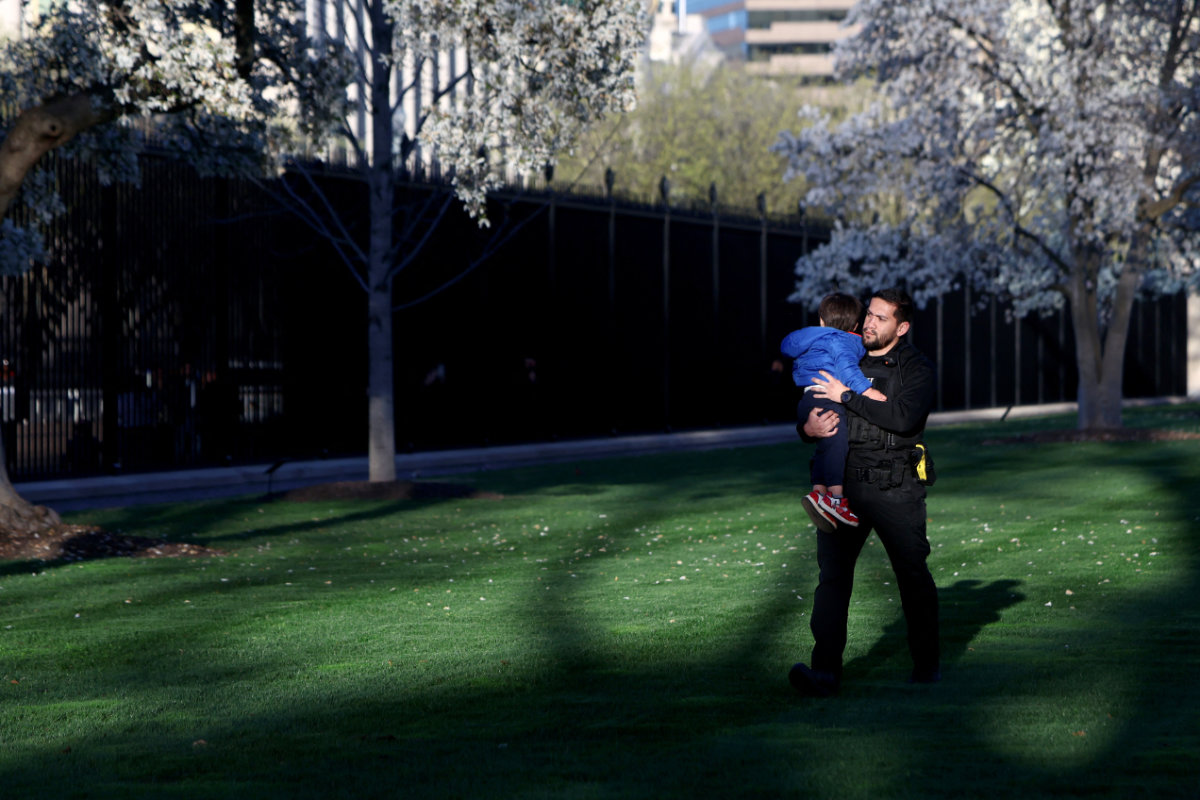ALEPPO: On the terrace of the Baron Hotel in Aleppo, the owner’s widow, Roubina Tashjian, sorted through old photographs of its happier past in a more peaceful Syria.
Founded by an Armenian family in 1911, the Baron played host to adventurers, writers, kings, aviators, Bedouin chiefs and presidents until war forced it to close five years ago.
Tashjian sees the Baron as part of a Syria that values religious and ethnic diversity, openness to the outside world, culture and respect for the country’s great antiquities. “A Syrian is a mixture of all these ethnic groups and cultures ... this is a big pot and it’s all mixed up. But we cook the same kibbeh,” she said, referring to a Levantine dish.
Trying to revive that vision of Syria amid a war that has aggravated social fractures would involve reconciliation between political opponents, religious sects and economic classes.
But with hundreds of thousands dead, more than half the country’s pre-war population displaced and fighting ongoing, there seems little hope of that for now.
For the Baron, whose business depended on stability, safety and the draw of Syria’s cultural treasures, the 2011 uprising was a catastrophic assault on everything that allowed it to thrive.
During most of the fighting, Aleppo’s government-held western districts were subjected to shellfire, an influx of refugees and shortages of water, electricity and food.
East Aleppo, held by rebels until December when the army swept through it after months of siege and air raids, was left all but a wasteland.
The Baron, in west Aleppo near the front line, was hit by mortar bombs, including one that sprayed shrapnel across an upper floor and another that crashed through the window of its “Oriental Room” onto delicate floor tiles but failed to explode.
The tail fin from that round now sits in the Baron’s cabinet of curiosities alongside such relics as pottery given by visiting archaeologists and T.E. Lawrence’s hotel bill.
In the upstairs room she always took during her frequent stays in Aleppo stands the glass-topped wooden desk where Agatha Christie wrote part of Murder on the Orient Express.
For supporters of President Bashar Assad it is the fault of rebels they describe as terrorists, viewing them as Islamist militants who despise diversity and criminal gangs who loot cultural treasures.
Assad has cast his state as a secular protector of Syria’s minorities and cultural heritage against Sunni rebels backed by hostile foreign states whose ranks include many hard-liners.
It was a view shared by some of the audience at a concert in an Old City church, fluttering fans in the summer heat of the open basilica, its roof ruined by shelling, as they listened to Mozart’s Mass in C Minor.
But any characterization of Assad’s Syria as diverse, secular, open and tolerant is rejected by the opposition, as well as some Western countries and rights groups. Critics say Syria’s government has long been one of the most oppressive in the Middle East and this was a root cause of the war.
The privileged position of Assad’s Alawite sect under him and his father, the late President Hafez Assad, fed grievances among many in the Sunni Muslim majority even as other Sunnis including urban elites backed the government.
While the government has promoted the idea of a secular Syria throughout the war, the conflict’s sectarian edge has been hard to miss.
As rebels rallied around Sunni Islamist slogans, Assad drew on allies including Shiite Islamist militias backed by Iran. They played a big part in the campaign to retake eastern Aleppo.
In the city, the conflict’s socio-economic dimensions are readily apparent. Areas where the rebellion was strongest included places bypassed by economic growth and poor quarters to which rural people flocked.
One west Aleppo resident, who had driven through devastated eastern districts after the fighting ended, said the inhabitants had brought ruin upon themselves by consorting with rebels.
“Those people were the cause. Yes, it’s sad, but...” the person said.
REFUGEE FAMILIES
In the Baron, the wood-panelled dining room, the bar stocked with antique bottles, the pink furniture of the high-ceilinged smoking room and the bedrooms all seem worn and tired.
It stopped taking paying guests in 2012 — bar a few old friends — when Syria’s civil war came to Aleppo and mortars and sniper fire began to plague the streets around.
Tashjian, a 66-year-old former teacher, chases away street kittens that creep through broken french windows into the dining room and tries to keep the mostly deserted hotel from falling further into disrepair in a city with little electricity or water.
Her husband, Armen Mazloumian, the grandson of the hotel’s founder, died in 2016, two years after they married following a 30-year friendship. The Baron now belongs to his sisters, who left Syria years earlier, she said.
On the terrace from which Egypt’s nationalist leader Gamal Abdel Nasser once addressed a huge crowd, the boxes of old photographs were surrounded by other detritus recently hauled from a basement after the fighting abated.
Kilims, antique sewing machines, a set of 1950s towels, and moldering linen imported from Europe and embroidered with the hotel’s name, cascaded from large rattan trunks.
During the fighting, the hotel took in refugee families from east Aleppo. While they were there they used so much water cleaning the floors of their rooms each morning that the elegant geometric tiles were damaged, Tashjian said.
In the late afternoon heat, the hotel is cooled by a breeze that drifts in through broken windows on the ground floor and up the grand staircase.
“Syria was the most comfortable, the most secular country in the Arab world,” said Tashjian. “It was embarrassing if people asked if you were a Christian or a Muslim.”
At historic Aleppo hotel, nostalgia for a Syria lost
At historic Aleppo hotel, nostalgia for a Syria lost

Arctic sea ice hits lowest peak in satellite record, says US agency

- Arctic sea ice forms and expands during the dark, frigid northern winter, reaching its seasonal high point in March
- In recent years, less new ice has formed, and the accumulation of multi-year ice has steadily declined
WASHINGTON: This year’s Arctic Sea ice peak is the lowest in the 47-year satellite record, according to data released by the US National Snow and Ice Data Center (NSIDC) on Thursday, as the planet continues to swelter under the mounting effects of human-driven climate change.
Arctic sea ice forms and expands during the dark, frigid northern winter, reaching its seasonal high point in March. But in recent years, less new ice has formed, and the accumulation of multi-year ice has steadily declined.
The maximum sea ice level for 2025 was likely reached on March 22, measuring 14.33 million square kilometers (5.53 million square miles) — below the previous low of 14.41 million square kilometers set in 2017.
“This new record low is yet another indicator of how Arctic sea ice has fundamentally changed from earlier decades,” said NSIDC senior research scientist Walt Meier in a statement.
“But even more importantly than the record low is that this year adds yet another data point to the continuing long-term loss of Arctic sea ice in all seasons.”
The Arctic record follows a near-record-low summer minimum in the Antarctic, where seasons are reversed.
The 2025 Antarctic sea ice minimum, reached on March 1, was just 1.98 million square kilometers, tying for the second-lowest annual minimum in the satellite record, alongside 2022 and 2024.
Combined Arctic and Antarctic sea ice cover — frozen ocean water that floats on the surface — plunged to a record low in mid-February, more than a million square miles below the pre-2010 average. That is an area larger than the entire country of Algeria.
“We’re going to come into this next summer season with less ice to begin with,” said Linette Boisvert, an ice scientist at NASA’s Goddard Space Flight Center in Greenbelt, Maryland. “It doesn’t bode well for the future.”
US scientists primarily monitor sea ice using satellites from the Defense Meteorological Satellite Program (DMSP), which detect Earth’s microwave radiation.
Because open water and sea ice emit microwave energy differently, the contrast allows sea ice to stand out clearly in satellite imagery — even through cloud cover, which obscures traditional optical sensors.
DMSP data is supplemented with historical records, including early observations from the Nimbus-7 satellite, which operated from 1978 to 1985.
While floating sea ice does not directly raise sea levels, its disappearance sets off a cascade of climate consequences, altering weather patterns, disrupting ocean currents, and threatening ecosystems and human communities.
As reflective ice gives way to the darker ocean, more solar energy is absorbed rather than reflected back into space, accelerating both ice melt and global warming.
Shrinking Arctic ice is also reshaping geopolitics, opening new shipping lanes and drawing geopolitical interest. Since taking office this year, US President Donald Trump has said his country must control Greenland, a Danish autonomous territory rich in mineral resources.
The loss of polar ice spells disaster for numerous species, robbing polar bears, seals, and penguins of crucial habitat used for shelter, hunting, and breeding.
Last year was the hottest on record, and the trend continues: 2025 began with the warmest January ever recorded, followed by the third-warmest February.
NOAA predicts that La Nina weather conditions, which tend to cool global temperatures, are likely to give way to neutral conditions that would persist over the Northern Hemisphere summer.
Polar regions are especially vulnerable to global warming, heating several times faster than the global average.
Since mid-2023, only July 2024 fell below 1.5 degrees Celsius of warming, raising concerns that the Paris Agreement’s goal of limiting long-term warming to 1.5C may be slipping out of reach.
Satanist leader’s attempt to hold ‘Black Mass’ inside US statehouse sparks chaos and arrests

- Kansas City-area Satanic Grotto rallied to protested what members called the state’s favoritism toward Christians in allowing events inside the statehouse
- Members of the satanic cult said their rally was in support free speech rights and religious freedoms guaranteed by the US Constitution’s First Amendment
TOPEKA, Kansas: The leader of a small group of self-described satanists and at least one other person were arrested Friday following a scuffle inside the Kansas Statehouse arising from an effort by the group’s leader to start a “Black Mass” in the rotunda.
About 30 members of the Kansas City-area Satanic Grotto, led by its president, Michael Stewart, rallied outside the Statehouse for the separation of church and state. The group also protested what members called the state’s favoritism toward Christians in allowing events inside. Gov. Laura Kelly temporarily banned protests inside, just for Friday, weeks after Stewart’s group scheduled its indoor ceremony.
The Satanic Grotto’s rally outside drew hundreds of Christian counterprotesters because of the Grotto’s satanic imagery, and its indoor ceremony included denouncing Jesus Christ, who Christians believe is the Son of God. About 100 Christians stood against yellow police tape marking the Satanic Grotto’s area. The two groups yelled at each other while the Christians also sang and called on Grotto members to accept Jesus. Several hundred more Christians rallied on the other side of the Grotto’s area, but further away.
Kelly issued her order earlier this month after Roman Catholic groups pushed her to ban any Satanic Grotto event. The state’s Catholic Bishops called what the group planned “a despicable act of anti-Catholic bigotry” mocking the Catholic Mass. Both chambers of the Legislature also approved resolutions condemning it.

“The Bible says Satan comes to steal, kill and destroy, so when we dedicate a state to Satan, we’re dedicating it to death,” said Jeremiah Hicks, a pastor at the Cure Church in Kansas City, Kansas.
Satanic Grotto members, who number several dozen, said they hold a variety of beliefs. Some are atheists, some use the group to protest harm they suffered as church members, and others see Satan as a symbol of independence.
Amy Dorsey, a friend of Stewart’s, said she rallied with the Satanic Grotto to support free speech rights and religious freedoms guaranteed by the US Constitution’s First Amendment, in part because Christian groups are allowed to meet regularly inside the Statehouse for prayer or worship meetings.
Before his arrest, Stewart said his group scheduled its Black Mass for Friday because it thought the Kansas Legislature would be in session, though lawmakers adjourned late Thursday night for their annual spring break. Stewart said the group might come back next year.
“Maybe un-baptisms, right here in the Capitol,” he said.
Video shot by KSNT-TV showed that when Stewart tried to conduct his group’s ceremony in the first-floor rotunda, a young man tried to snatch Stewart’s script from his hands, and Stewart punched him. Several Kansas Highway Patrol troopers wrestled Stewart to the ground and handcuffed him. They led him through hallways on the ground floor below and into a room as he yelled, “Hail, Satan!”
Stewart’s wife, Maenad Bee, told reporters, “He’s only exercising his First Amendment rights.”

Online records showed that Stewart was jailed briefly Friday afternoon on suspicion of disorderly conduct and having an unlawful assembly, then released on $1,000 bond.
Witnesses and friends identified the young man trying to snatch away the script as Marcus Schroeder, who came to counterprotest with fellow members of a Kansas City-area church. Online records show Schroeder was arrested on suspicion of disorderly conduct, with his bond also set at $1,000.
Dorsey said two other Satanic Grotto members also were detained, but didn’t have details. The Highway Patrol did not immediately confirm any arrests or detentions.
A friend of Schroeder’s, Jonathan Storms, said he was trying to help a woman who also sought to snatch away Stewart’s script and “didn’t throw any punches.”
The woman, Karla Delgado, said she came to the Statehouse with her three youngest children to deliver a petition protesting the Black Mass to Kelly’s office. Delgado said she approached Stewart because he was violating the governor’s order and Highway Patrol troopers weren’t immediately arresting him. She said in the ensuing confusion, her 4-year-old daughter was knocked to the ground.
“When we saw that nobody was doing anything — I guess just in the moment of it — it was like, ‘He’s not supposed to be allowed to do this,’ so we tried to stop him,” she said.
Child slips through fencing at White House and is intercepted by Secret Service

- Similar intrusions have happened at th White House before, including in April 2023 when a toddler squeezed through the metal fencing
WASHINGTON: A child slipped through fencing outside the White House on Wednesday and was intercepted by Secret Service officers.
Secret Service spokesperson Anthony Guglielmi said the young trespasser squeezed through the fence on the North Lawn around 6:30 p.m., about an hour after President Donald Trump announced planned auto tariffs from the Oval Office.
“Officers quickly reunited the child with their parents without incident,” Guglielmi said in a social media post.

Video posted on social media shows an armed officer carrying a young child wearing a blue hooded sweatshirt across the lawn before handing off the child to another officer.
Such intrusions have happened before. In April 2023, a toddler squeezed through the metal fencing, also on the North Lawn, and was later reunited with his parents, who were briefly questioned.
It was bacteria — not a miracle — on a communion wafer in US church

- The host, or bread, with red marks had fallen out of a Mass kit at St. Anthony Church in Morris, Indiana
- A biochemical analysis revealed only “fungus and three different species of bacteria, all of which are commonly found on human hands”
MORRIS, Indiana: A laboratory analysis turned up nothing miraculous about red marks found on a Communion wafer at a Catholic church in Indiana.
The discovery at St. Anthony of Padua Catholic Church in Morris was unusual enough for a formal inspection, the Archdiocese of Indianapolis said.
But a biochemical analysis revealed only “fungus and three different species of bacteria, all of which are commonly found on human hands,” the archdiocese said Monday, adding that no blood was found.

The Catholic faith teaches that wine and a bread wafer signify the body and blood of Jesus Christ. Typically, they’re consecrated by a priest at Mass.
The host, or bread, with red marks had fallen out of a Mass kit at St. Anthony Church.
“Throughout the history of the Catholic Church, there have been well-documented miracles and apparitions, and each has been thoroughly and carefully reviewed,” the archdiocese said.
Before the analysis, some members of St. Anthony Church were excited about what might be found.
“We have such a little town. You can drive through and blink and you’re through it,” Shari Strassell, a church member, told WKRC-TV. “It means the world, it does, and I think there is something special about our church up here.”
Japan awards longest-serving death row inmate $1.4 million

- Payout represents 12,500 yen ($83) for each day of the more than four decades that Iwao Hakamada spent in detention
- The former boxer was exonerated last year of a 1966 quadruple murder after a tireless campaign by his sister and others
TOKYO: A Japanese man wrongly convicted of murder who was the world’s longest-serving death row inmate has been awarded $1.4 million in compensation, an official said Tuesday.
The payout represents 12,500 yen ($83) for each day of the more than four decades that Iwao Hakamada spent in detention, most of it on death row when each day could have been his last.
It is a record for compensation of this kind, Japanese media said.
The former boxer, now 89, was exonerated last year of a 1966 quadruple murder after a tireless campaign by his sister and others.
The case sparked scrutiny of the justice system in Japan, where gaining a retrial is notoriously hard and death row inmates are often informed of their impending death just a few hours before they are hanged.
The Shizuoka District Court, in a decision dated Monday, said that “the claimant shall be granted 217,362,500 yen ($1.44 million),” a court spokesman told AFP.
The same court ruled in September that Hakamada was not guilty in a retrial and that police had tampered with evidence.
Hakamada had suffered “inhumane interrogations meant to force a statement (confession)” that he later withdrew, the court said at the time.
Hakamada’s legal team said the money falls short of the pain he suffered between his 1966 arrest and his release in 2014, when he was granted a retrial.
“I think the fact that he will receive it... compensates him a little bit for all the hardship,” lawyer Hideyo Ogawa told a press conference.
“But in light of the hardship and suffering of the past 47 or 48 years, and given his current situation, I think it shows that the state has made mistakes that cannot be atoned for with 200 million yen,” he said.
Decades of detention – with the threat of execution constantly looming – took a major toll on Hakamada’s mental health, his lawyers have said, describing him as “living in a world of fantasy.”
Hakamada was convicted of robbing and killing his boss, the man’s wife and their two teenage children.
He initially denied the charges but police said Hakamada eventually confessed.
During his trial, Hakamada claimed innocence, saying that his confession was forced.
More than a year after the killings, investigators said they found blood-stained clothes – a key piece of evidence that the court later said was planted by investigators.
Hakamada now lives with his sister with help from supporters.
Hakamada was the fifth death row inmate granted a retrial in Japan’s post-war history. All four previous cases also resulted in exonerations.
Japan is the only major industrialized democracy other than the United States to retain capital punishment, a policy that has broad public support.
Japan’s justice minister said in October that abolishing the death penalty would be “inappropriate” even after Hakamada’s acquittal.



















